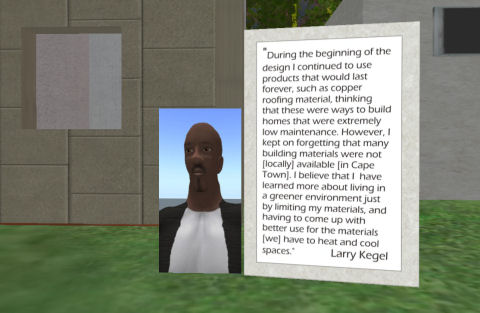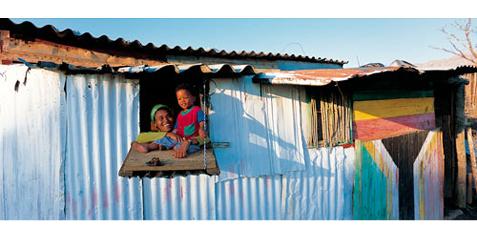Cape Town Housing Project in Second Life
The newly-elected South African government quickly recommitted itself to deliver at scale “to ensure that by 2014 South Africa is free of slums”. Housing has always been one of the key deliverables for governments across Africa and with millions living in unsafe conditions, it remains an indicator of urban health. The World Bank refers to three issues related directly to housing:
“First, direct linkages with the energy sector in combating indoor air pollution, still one of the top causes of death and disease in developing countries. Second, quality of life improvements stemming from overall living conditions in individual homes as well as communities. Third, high death and injury rates from household accidents”.
In March, a new agency was launched by the South African government to reach targets and deliver a minimum of 500 000 new housing units every year. South Africa had its 2009 national elections a few weeks ago, and although the African National Congress (the party of Nelson Mandela – ANC) lost some ground, it got another vote of confidence from most South Africans to deliver on some of its promises.
Attention to housing delivery is not unique to South Africa: In some states in the USA there are specific quotas for new developments where 15% of units in new developments needs to be for low-income families. The concept of ‘inclusionary housing’ has also been researched well in South Africa and was recommended as a viable alternative to rapid delivery of houses – in favour of building neighborhoods that also address spatial inequity and segregation.
So, when Profesora Farigoule (SL) of Delaware Technical & Community College in the USA and Alanagh Recreant (SL) of Uthango Social Investments in South Africa met, the potential to ‘do something meaningful’ in terms of architecture related to Africa surfaced from the first conversation. Sustainable housing development in townships was the logical starting point, resulting in a ground-breaking project by the College to deliver concept sketches and a visual presentation of plans to its nonprofit client across the Atlantic after collaborating inSL. In the small Capetonian neighborhood – now on exhibit here in Second Life – students share what the project meant to them and how they approached it:

Please consider visiting the initiative on a piece of digital land at Architectural Island inSL. The students’ own blog describes the objective of the DTCC/Uthango project:
“to investigate proposals for sustainable design housing prototypes for use in the redevelopment effort in South Africa to replace existing marginal housing in the township areas. Our focus was in the Cape Town, South Africa area as we have contact with the Uthango Social Investments group though Second Life”.
In our opinion, the contact between Uthango and the students could have been a bit more, but their understanding of our clients ‘ needs were sufficient during some in-process visits. Jango Carducci (inSL) describes the project as “fun and challenging” and from the brief interaction with this new ‘designer/builder’ it was obvious that the project was taken seriously and attention was given to details – given the SL building skills acquired in a short period of time. (However, it would be a mistake to focus on the actual builds and not on the lessons learned via the entire process of rendering a 3D-model from a concept sketches. This is also pointed out by Keystone Brouchard via the respected The Arch Network).
Their proposed plans took into account sustainable practices, and students like Larry Kegel (SL) designed a house with minimal building materials.


The understanding of the cultural and historical context actually became the more important component of this project – the development of mindsets of the students and meaningful application of their creativity and design skills. (The enthusiasm of the majority of students is appreciated).
The focus on Cape Town was recommended by Uthango, the client, as it is the location of the national operational office of the organization. More importantly, Cape Town itself struggles with a backlog of housing and is considered a very divided city: There are more than 220 informal settlements in Cape Town alone and more than a million citizens live in shacks – with a conservative number of 400 000 families without stable and safe homes.
Many of Uthango’s clients (micro-entrepreneurs and community leaders) and own staff members face harsh conditions, as evident during the recent storm. Cape Town Disaster Management teams say at least 11 informal settlements have been flooded by the mid-May 2009 storm and about 700 people have been affected (SABC News). On the National Housing Spatial Investment grid, Cape Town is also indicated as highly suitable with a high need (in green beneath), due to its 220+ informal settlements.

There is little doubt that more and more educational institutions are adopting virtual worlds as a appropriate medium for learning. The potential to relate across geographical boundaries has been demonstrated in this project between an USA-based College and an African-based NGO concerned with improving the lives of its beneficiaries. In this format it serves as a good demonstration for governments and civil society as rightfully pointed out by Kwame Oh in an ‘Enterprise Tour’ forum of Linden Lab. Also note: “International expansion” priorities and plans were expressed as a strategic direction by M Linden at Metanomics – but Uthango in South Africa did not get the impression that “international’ also include the African continent – despite the following statement:
“Developing economies are definitely a part of our future. In fact, our growth has been surging lately in developing markets around the world. The beauty of the Second Life experience and economy is that you can be anywhere in the world and participate if you have a computer and are connected to the grid…and many people do”. (Mark Kingdon, CEO Linden Lab)
Maybe we are wrong to assume a ‘continental oversight’ from Linden Lab, or even to expect it in these times of financial turmoil. Later, we will be able to tell what the company’s strategy was/is related to African access to and use of Second Life – if any. The current usage of less than 1% is not only an indicator of access issues, but also reflects on the lack of attention by developers and VWs pioneers to the continent and its potential as an emerging market for virtual reality applications.
The greatest value of this project is afterall locked in the creation of global understanding between people, and opening up avenues for insight into the lives of others. Henry Thoreau (1817 – 1862) pointed us to this piece of wisdom and hopefully we are moving a bit closer by applying virtual worlds in the way we did: “What is the use of a house if you haven’t got a tolerable planet to put it on?“
The project has potential to improve at various levels and we hope to be doing so in the next rounds. For instance, it would be highly beneficial to students and the clients of Uthango to conduct a situational analysis related to individual clients and design the ideal home on the actual piece of land for the family. Feedback from clients via webcams could close the contextual gap even further.

In the mean time, Uthango continues its ad hoc engagement with fellow NGOs and Trusts responsible for housing delivery against the government’s policies and vision: The development of sustainable human settlements rather than delivery of masses of tiny identical homes will contribute to security, comfort and dignity. The organisation is in the process of forging strategic linkages with companies and investors interested in alleviating housing challenges in South African informal settlements. As reported by Architect Africa Online, the appointment of business-savvy Tokyo Sexwale as Minister of Human Settlements is indeed encouraging in this respect.
In the end, this Second Life project is not ABOUT houses – just like the initiatives of African governments – but about the broader goal of impacting positively on the living conditions and socio-economic well-being of all people in South Africa. InSL, it is also not about creating an ‘augmented reality’ to duplicate building styles for the sake of representing it visually – Second Life is surely not the best 3D programme to be doing this architecturally. This is ultimately about the engagement, the learning, the opportunity to expose the project to a wider audience and sphere of interest. Indeed, it is about influencing the way in which we understand the world beyond our region and our classrooms. (Thank you Profesora Farigoule and Delaware College in USA, and the shared vision). We hope to be working closely with more and more educational institutions and companies in virtual worlds and add context and content to creative process.
Who would have thought?! A few dedicated ‘avatars’ with strange names in a ‘Second Life’ could visually influence the dreams of families living in dire poverty and desperation in Africa?
